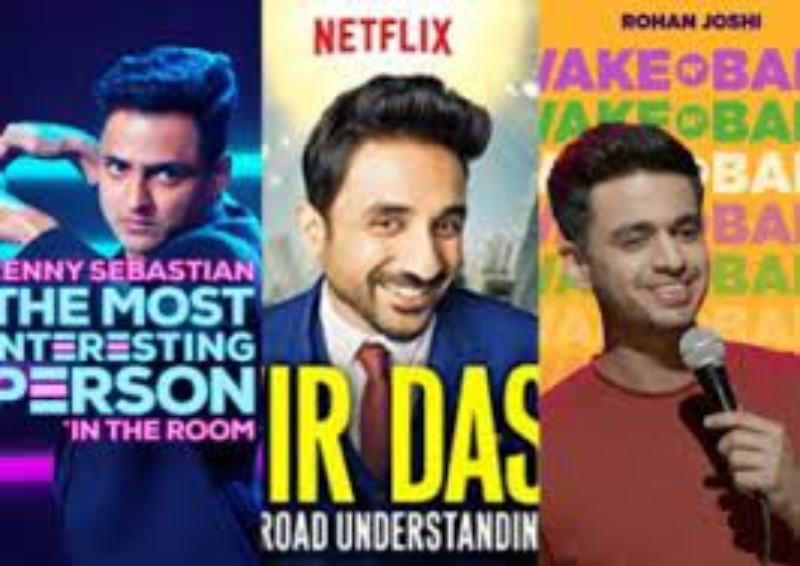Stand-up comedians get digital boost in India
Comedians have for long been popular in Indian film and television industry, with a mass appeal for comedy on the silver screen as well as the idiot box. Besides the stalwart comedians of the films, such as Johnny Walker or Mehmood or Kader Khan, there have also been numerous comedians on the television. In the past two decades, a number of comic artists like Rahul Srivastav, Ahsaan Qureshi and Sunil Pal made their own shows like The Great Indian Laughter Challenge that proved to be big hits on the television.
However, until a few years ago, a stand-up industry, like in the western world, where people would specially pay to come to watch a solo artist was literally non-existent.
A quick scroll through any young adult’s YouTube feed today will make it clear, who is king in the entertainment industry, and while movies and serials continue to rule a significant part of the market, stand-up comedians have swiftly carved a niche for themselves.
Anyone who isn’t living under a rock has at least once or twice come across the works of comedians like, Vir Das, Kaneez Surkha, Kenny Sebastian, Kanan Gill, Biswa Kalyan Rath and Abhimanyu Upmanyu, it’d be a gross understatement to say that the digital platforms like YouTube, Netflix, and Amazon Prime have played a big role in expanding their fan bases beyond imagination.
“I wasn’t even aware that India had any stand-up comic scene at all,” says Prabhat Nagpal, a 31-year-old banker and an armchair comedian from Delhi, “until YouTube started suggesting some stand-up videos on my feed. I think at that point YouTube saw potential in the country’s comics and were probably pushing them through their algorithm.”
YouTube India launched in the May of 2008. This gave the Indian audiences an outlet to the world, especially the young who were always on the lookout for new and exciting content. At first there was a considerable amount of gap between the quality and quantity of content being produced around the world and in India but with time this gap slowly filled up with talented and diverse group of YouTubers that soon found recognition among the Indian viewers.
And perhaps there is no bigger innovator when it comes to the online comic industry than All India Bakchod or AIB for short. “AIB were a game changer in my opinion, their brand of comedy resonated with the younger audiences who could now watch them online for free,” Nagpal tells Media India Group.
AIB was founded in 2012 by four comedians, Tanmay Bhat, Rohan Joshi, Gursimran Khamba and Ashish Shakya, who have been successful, collectively as well as individually.
Soon enough other comedy collectives like East India Comedy (EIC) and Shits and Giggles (SnG), followed and found considerable recognition on YouTube. Indian comic scene was still in its early years when it got another big boost in 2015.
OTTs prop up stand-up comics in India
When it launched in 2015, Jio, telecom business of Mukesh Ambani-led conglomerate Reliance, gave away loads of free data with its 4G service and suddenly hundreds of millions of Indians had access to unlimited data on relatively cheap smartphones. Atlas, a virtual private network, says that in 2015, just over 130 million Indians had internet connectivity and by 2020, this number had exploded to 688 million in 2020. By 2025, Atlas expects this number to top 1 billion.
This dramatic boom in access to unlimited data on smartphones at relatively cheap rates has led to the creation of a huge pool of audiences hunting for exciting content on the internet and is the principal reason for the growth of nearly all social media platforms in India, but specially Facebook, YouTube and WhatsApp, besides the OTT platforms, which offer a vibrant channel for new types of entertainment content. Now there was a whole new and quite a large unexplored audience for comedians to entertain.
Netflix, world leader amongst OTTs and now one of the biggest producers of entertainment and cinema in the world, reached India in 2016. “Until Netflix came in, there was a big issue with money. There was almost no money in comedy. Until you were not a big-time comic, who could book full rooms any given day of the year, then you were probably struggling to make ends meet,” says Nagpal.
Netflix has proven to be hugely popular in India as well, though it has to compete with its global rivals like Amazon or Disney, but also Indian offers like Zee. Netflix had over 3 million subscribers in India by the end of 2020, 33 pc more than 2019. To stay ahead in the game, Netflix has used the same strategy as elsewhere in the world – shower money on producing original content. This has led to comedians getting hefty paychecks, and a financially rewarding stand-up career.
Vir Das became the first Indian comic to have his own Netflix Special in 2017 titled, Vir Das: Abroad Understanding. It received praise from critics and fans alike. “In India, the genre of stand-up comedy is in its nascent stage. The entertainment genre was dominated largely by Bollywood and Bollywood superstars. But now thanks to the internet, the first generation of homegrown stand-up comics are taking the nation by storm,” wrote a critic in FirstPost, an internet newsplatform.
“Vir Das is an OG among English language comics, he has paved the way for many. So it was only fair that he gets to be the path breaker here too,” says Nagpal.
After Vir Das, there have been the likes of Kenny Sebastian, Kannan Gill and many more who have gone on to have their own special programmes on Netflix.
Netflix’s global rival, Amazon Prime, too has made a significant headway in India. In fact, with significantly lower subscription rates, Amazon Prime has leaped ahead of Netflix in India and it reportedly counted over 38 million subscribers at the end of 2020. Besides lower access rates, Amazon Prime has also spent a lot more in generating India-centric content than both One click will show you the whole spectrum of specials from comedians from the North to the South of India.
The OTT platforms have helped the quality of content become fresher, edgier, and funnier than ever. “OTT platforms have brought much needed healthy competition into the industry, it’s difficult business making people laugh, if they don’t find you funny, they can just move on to the next special,” Nagpal tell Media India Group.










